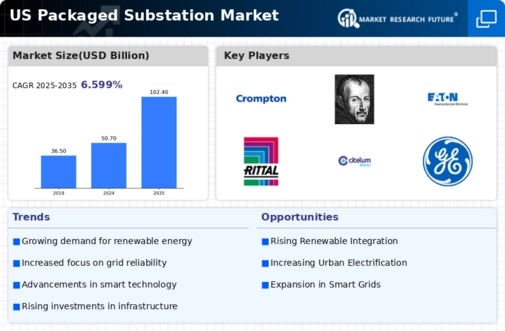Growing Focus on Energy Resilience
The increasing emphasis on energy resilience is a crucial driver for the packaged substation market. Natural disasters and extreme weather events have highlighted the vulnerabilities of traditional power systems, prompting utilities to seek more resilient solutions. Packaged substations, with their modular design and ability to be deployed in various environments, offer a robust alternative. The US energy sector is witnessing a shift towards solutions that can withstand disruptions, with investments in resilient infrastructure projected to reach $100 billion by 2027. This trend suggests that the packaged substation market will experience growth as utilities prioritize resilience in their energy distribution strategies.
Investment in Infrastructure Modernization
The ongoing investment in infrastructure modernization across the US is significantly impacting the packaged substation market. With aging electrical infrastructure, utilities are compelled to upgrade their systems to enhance reliability and efficiency. The US government has allocated substantial funding for infrastructure projects, with an estimated $1 trillion earmarked for improvements over the next decade. This investment is expected to drive the adoption of packaged substations, which provide a streamlined and efficient solution for modernizing power distribution networks. The packaged substation market stands to gain from this trend, as utilities seek to replace outdated equipment with more advanced, compact, and efficient solutions that can be integrated into existing networks.
Rising Demand for Efficient Power Distribution
The increasing demand for efficient power distribution systems is a primary driver for the packaged substation market. As urbanization accelerates in the US, the need for reliable and efficient energy solutions becomes paramount. Packaged substations offer a compact and integrated solution that minimizes energy losses and enhances distribution efficiency. According to recent data, the US energy consumption is projected to rise by approximately 20% by 2030, necessitating the deployment of advanced power distribution systems. This trend indicates a growing market for packaged substations, as they can be deployed quickly and effectively to meet the rising energy demands. Furthermore, the packaged substation market is likely to benefit from the increasing focus on reducing operational costs and improving energy efficiency in power distribution.
Technological Innovations in Energy Management
Technological innovations in energy management systems are reshaping the packaged substation market. The integration of advanced monitoring and control technologies allows for real-time data analysis and improved operational efficiency. As utilities in the US adopt smart grid technologies, the demand for packaged substations equipped with these innovations is likely to rise. The market for smart grid technologies is expected to grow at a CAGR of 15% through 2028, indicating a strong potential for packaged substations that can seamlessly integrate with these systems. The packaged substation market is poised to benefit from this technological evolution, as utilities seek to enhance their operational capabilities and improve service reliability.
Regulatory Incentives for Clean Energy Solutions
Regulatory incentives aimed at promoting clean energy solutions are driving the packaged substation market. The US government has implemented various policies to encourage the adoption of renewable energy and energy-efficient technologies. These incentives include tax credits and grants for utilities that invest in modernizing their infrastructure with sustainable solutions. As a result, the packaged substation market is likely to see increased demand as utilities seek to comply with regulatory requirements while enhancing their operational efficiency. The potential for financial benefits through these incentives may further accelerate the adoption of packaged substations in the US energy landscape.






















Leave a Comment